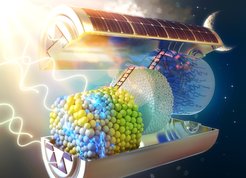Batteries go solar
An integrated solar battery based on a charge storing 2D carbon nitride
The avenues to steer our society’s energy supply into a sustainable future are manifold, and harvesting abundant solar radiation is likely one of the most promising approaches. However, to date significant challenges arise, such as the fluctuation of the solar flux, which in return produces intermittencies on timescales of months (winter-summer), days (day-night), or minutes to hours (weather). Scientists at the Max Planck Institute for Solid State Research and LMU Munich have now reported a novel bifunctional solar battery device, which attempts to tackle these challenges by engineering a charge storage functionality into an organic based solar cell. The device relies on a bifunctional carbon nitride photoanode to harvest sunlight and store its energy on a single material via long-lived trapped electrons. The novel device architecture enables simultaneous light charging and electric discharging, and significantly facilitates implementation as a charge storing solar cell for both larger scale solar farms and small scale microdevices based on the high level of system integration.

Supplying society with renewable energy is paramount. Solar energy is a key ingredient in the renewable energy mix due to the vast surplus of solar irradiation – however, implementation proves to be challenging. This is because the energy demand fluctuates over the day and so does the availability of solar energy, with both often being out of phase. The resulting energy demand curve looks like a duck, hence it is often referred to as the “duck curve”. To better match the demand with the supply, a solar storage functionality – a solar buffer – would be required, which smoothens out the ”duck curve” and makes solar energy available also at times when the sun does not shine.
The emerging field of solar batteries aspires to close this short-term energy storage gap. As such, it holds promise not only for large-scale solar light harvesting, but also for energy autonomous microdevices. A solar battery integrates a charge storage function into a solar cell, enabling “light storage”. However, this high level of system integration requires orchestration of different photophysical and electrochemical processes in one or a few materials, leading to several conceptional challenges. For example, while one photogenerated charge carrier (e.g., an electron) is stored on the light absorbing electrode, the other charge carrier (e.g., hole) needs to be transferred to the counter electrode.
Herein, for the first time, a bifunctional photoanode is combined with an internal charge transfer cascade using a multifunctional organic polymeric battery separator, which simultaneously serves as a rectifier and hole transporter to the organic based cathode (Fig. 2, left and middle). Bifunctionality implies that the material must perform two operations at the same time – light absorption and charge carrier generation on the one hand, and long-term storage of one of the charge carriers on the other hand. Here, the 2D polymeric carbon nitride potassium poly(heptazine imide), K-PHI, provides this key functionality. Its earth-abundant, ionic structure uniquely combines optoelectronic and ionic features that enable light absorption and charge storage of the light-induced electrons in trap states.

Typically, carbon nitrides are investigated for photocatalytic water splitting, where photoexcited electrons reduce water to hydrogen, and photoexcited holes are extracted via an electron donor such as methanol or water – the latter producing oxygen. In a solar battery, one requires a “reversible” charge extraction process. This reversibility is achieved by means of a thin layer of the conductive polymer F8BT on top of a K-PHI thin film, which acts as hole transport material. The hole transporter shuttles the holes into the conductive polymer PEDOT:PSS, which serves as a cathode storing positive charges. By engineering this ladder-type cascade via suitably aligned valence band edges of K-PHI, F8BT and PEDOT:PSS, hole transfer is rectified and self-discharge is inhibited. Notably and contrary to most current solar battery designs, this process occurs via an internal heterojunction rather than an external circuit.
Three distinct modes result from this special device architecture: Operation as a solar cell, a battery, and a light-assisted battery. In solar cell mode, the device provides a continuous photocurrent. When operated as a battery, electric charging and on-demand discharging can be performed by applying a suitable current. In the light-assisted battery mode, the solar battery can be charged with light, while simultaneously being electrically charged or discharged, leading to an energy improvement of up to 94.1% in comparison to operation as a normal battery (Fig. 2, right). In the limit of small discharging currents and sufficient light intensity, a solar battery can be envisaged that never fully discharges under illumination – provided that the electric discharging current is smaller than the internal charging photocurrent.
This new generation of “light storing” devices opens up new perspectives of how to address the energy storage gap in times where sunlight is not available, i.e. at night or during cloud overcast. The earth-abundance, scalability and high level of integration of this solar battery design caters to both large-scale solar “buffer” applications in solar farms, for local home-scale applications, or small-scale, self-powered autonomous devices. Since the device can be made translucent, energy harvesting applications integrated in smart windows or wearable electronic devices can be envisaged, which further widens the scope of solar battery applications due to reduced system complexity and easy miniaturization.
The future of batteries is bright!













